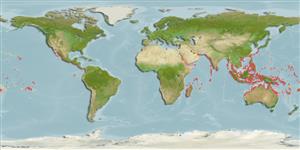>
Gobiiformes (Gobies) >
Gobiidae (Gobies) > Gobiinae
Etymology: Bathygobius: Greek, bathys = deep + Latin, gobius = gudgeon (Ref. 45335).
More on author: Rüppell.
Environment: milieu / climate zone / kisaran kedalaman / distribution range
Ekologi
laut; air tawar; payau berasosiasi dengan karang; amphidromus (Ref. 51243); kisaran kedalaman 0 - 6 m (Ref. 86942). Tropical; 30°N - 30°S
Indo-Pacific: Red Sea south to Bazaruto, Mozambique (Ref. 2798) and east to the Line and Tuamoto islands, north to South Korea and southern Japan, south to the southern Great Barrier Reef. Does not occur in the Hawaiian Islands (Ref. 7490).
Size / Weight / umur
Kematangan: Lm ? range ? - ? cm
Max length : 12.0 cm TL jantan/; (Ref. 4343)
deskripsi pendek
Kunci identifiaksi (pengenalan) | Morfologi | Morfometrik
Duri punggung (Keseluruhan (total)) : 7; duri punggung lunak (Keseluruhan (total)) : 9; Duri dubur: 1; Sirip dubur lunak: 8. Characterized further by pale yellowish brown color with large, irregular dark brown blotches on body; small, pale blue spots (one per scale) in longitudinal rows on body; dorsal and caudal fins with small blue spots, outer edge of dorsal fins broadly yellow; upper three pectoral rays partly free of membrane; rounded caudal fin; longitudinal scale series 29-36; predorsal scales 10-19, reaching from above middle of preopercle nearly to interorbital space; cheek and opercle without scales; ctenoid body scales, becoming cycloid on abdomen, breast and nape; depressed head, width greater than depth; depth of body 4.4-5.0 in SL (Ref. 90102).
Body shape (shape guide): fusiform / normal.
Inhabits shallow rocky areas, often in pools of the intertidal zone (Ref. 2798). Occurs mostly in coastal areas. Also found in estuaries, tidal zones and often ascending into freshwater streams; smaller species live between branches of corals where they exploit several crustacean groups. Feeds on crustaceans, fish and algae (Ref. 92840). Sometimes seen as fresh catches at markets (Ref. 12693).
Life cycle and mating behavior
Kematangan | Reproduksi, perkembang biakan | Pemijahan | telur-telur | Fecundity | Larva
Benthic spawner. Also Ref. 32023.
Hoese, D.F., 1986. Gobiidae. p. 774-807. In M.M. Smith and P.C. Heemstra (eds.) Smiths' sea fishes. Springer-Verlag, Berlin. (Ref. 2798)
Status IUCN Red List (Ref. 130435: Version 2025-1)
ancaman kepada manusia
Harmless
penggunaan manusia
Perikanan: nilai komersial kecil
Alat, peralatan
laporan khas
muat turun XML
Sumber internet
Estimates based on models
Preferred temperature (Acuan
123201): 24.9 - 29.3, mean 28.4 °C (based on 3467 cells).
Phylogenetic diversity index (Acuan
82804): PD
50 = 0.5000 [Uniqueness, from 0.5 = low to 2.0 = high].
Bayesian length-weight: a=0.01023 (0.00477 - 0.02194), b=3.01 (2.83 - 3.19), in cm total length, based on LWR estimates for this (Sub)family-body shape (Ref.
93245).
Trophic level (Acuan
69278): 3.4 ±0.6 se; based on diet studies.
Daya lenting (Acuan
120179): Tinggi, Waktu penggandaan populasi minimum kurang dari 15 bulan (Preliminary K or Fecundity.).
Fishing Vulnerability (Ref.
59153): Low vulnerability (10 of 100).
🛈
Nutrients (Ref.
124155): Calcium = 114 [61, 258] mg/100g; Iron = 0.861 [0.426, 1.636] mg/100g; Protein = 18.7 [16.7, 20.4] %; Omega3 = 0.134 [0.057, 0.266] g/100g; Selenium = 15.1 [7.5, 32.3] μg/100g; VitaminA = 195 [53, 659] μg/100g; Zinc = 2.01 [1.31, 3.06] mg/100g (wet weight);
